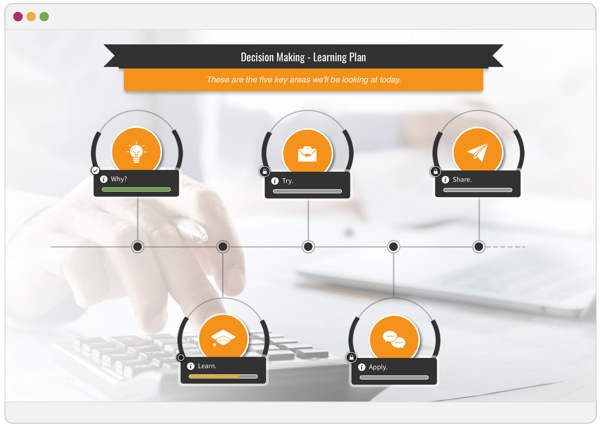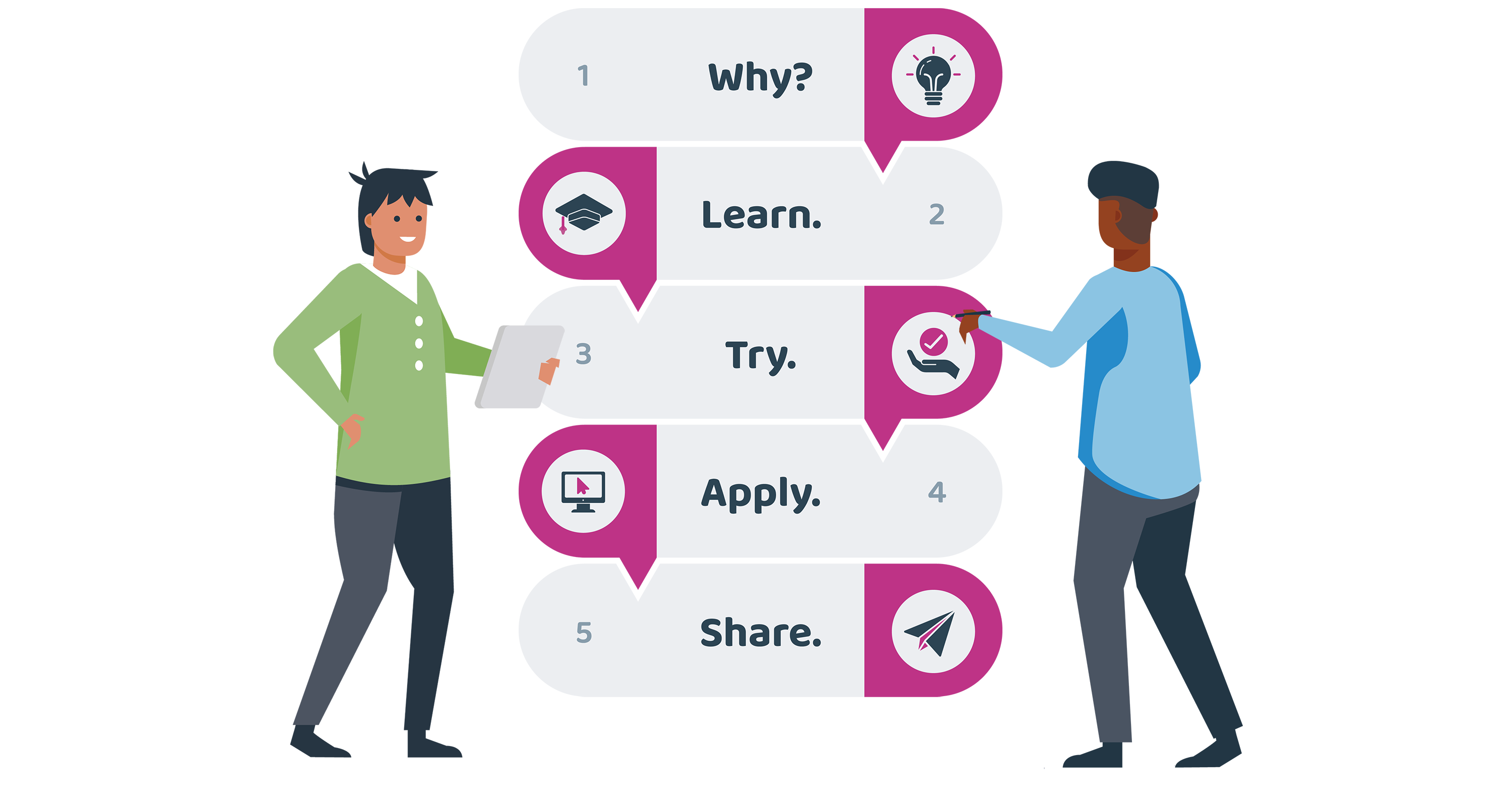Learning designers are spoilt for choice when it comes to frameworks and models for planning and designing learning. From classic pedagogical tools like Bloom's Taxonomy to models informed by twenty-first-century design thinking, theories and resources are abundant. At Guroo Learning, we have adopted our own approach to structure our learning solutions in a logical flow that allows the learner to practice to learn, practice, and (most importantly) apply their learning on the job.
There are five phases to this model; why, learn, try, apply and share. One of the key strengths of this model is that it can be applied at the design stage—when mapping out the learning journey— as well as when building the individual learning components, as seen in the Learning Plan example below. This example is taken from a module we designed as part of a decision-making program for a major Australian financial institution. The program focuses on improving strategic decision-making and data analytics skills among the company's middle-managers.

 Why?
Why?
The Why is perhaps the most important question we ask our clients and ourselves when we set out to design a program, as it helps inform the approach we take to the project. Questions to ask at this stage include:
-
Why does the client need this program created? (What problem are we trying to solve)
-
Why would the learner want to engage? (What are their intrinsic or extrinsic motivations)
-
Why would the learner not want to engage? (What are some potential barriers to participation)
The Why should be made clear to the learner at the outset of any training. The goal of stating the Why is to help the learner answer the "Why should I bother?" (commonly expressed as 'What's in it for me?' or WIIFM) and get buy-in. Stating what the learner can expect from the training can help them form their Why, which can range from deeply intrinsic if they've sought out the training on their own accord ("This training will allow me to develop new skills and grow as a person") to acutely extrinsic, which might be the case in compliance-related training ("I have to do this training to meet the requirements of my job"). Wherever your learners land on the intrinsic/extrinsic scale of motivation, you should be open with the reason you want them to pay attention.
| In the module we developed on decision-making tools, the Why phase provides some context for the decision-making processes covered in the module, and why these are important to the organisation. We included an interview with a senior leader on how tools can help leaders make better decisions (to show the link to business goals and add credibility), and some quick vox pops from people around the organisation on the decision-making tools they use and why they use them (to show them how the learning will help them do their job better). |
 Learn.
Learn.
This step is where we design the learning journey and map out the balance between face-to-face, self-paced learning, group activities, or whatever components the project requires. Mapping out the learning journey also involves ensuring that the content that is presented is tailored to the audience, accessible, relevant and engaging. Whether the program is a one-off 15 minute eLearning module or a work-integrated project spanning months, planning each step of the learning before designing it is essential.
Learn is the part of the training where the learner is acquiring new knowledge or skills. Importantly, knowledge acquisition should not be limited to a one-way transfer of information, but rather be an interaction between the learner and the content. This can be promoted by adding reflective questions or even assessed questions with rich feedback.
| In the ‘Learn’ section of our decision-making eLearning, the ‘virtual coach’ takes the learner through the key decision-making processes. Along the way, they answer some questions to keep them engaged and ensure understanding. When the learner meets a learning milestone (based on the learning objectives) they are rewarded with a badge. |
 Try.
Try.
In the design stage, trying means designing opportunities for the learner to have a go at trying out their newfound skills or knowledge in a safe environment. This is particularly useful for compliance training where real-world stakes can be high. Scenarios are great for this purpose.
As a designer, once you've established that you want to use scenarios, ensure that they are as authentic as possible. For example, if the course you're creating is training staff at a bank to spot suspicious activity from viewing account statements, asking them to download a mock-up statement and answer questions about it might be a good approach. If you are preparing retail customers for dealing with challenging customers, perhaps a video with actors playing out scenarios, followed by reflective questions could be quite effective.
Whichever way you chose to do it, it is important that the learner feels supported and that they receive detailed feedback as they progress, particularly where capability gaps exist.
| In our module on decision-making processes, the ‘try’ section presents the learner with a real-world scenario about improving the customer experience. The learner needs to apply the frameworks they have learned, in order to identify the problem, decide what decision-making tools they should use, and make a decision on how to solve the problem. As they move through the scenario, they receive tailored feedback from the ‘virtual coach’ and are directed to additional learning where needed. |
 Apply.
Apply.
Designing learning that takes application and job transfer into account can be time-consuming, as it requires support from managers and wider stakeholders. However, it is crucial in order to ensure that learning continues, even after the formal training is over.
Whether completed as a project throughout the training or as a separate task upon completion, application activities should be authentic and bring real value in order to be engaging and achieve buy-in from the learner and their organisation.
| In our decision-making module, the learner is tasked with applying the key processes to a decision they are facing in their own role. This is supported by an interactive job aid to assist them in selecting the right decision-making tools. |
 Share.
Share.
Sharing once newly acquired skills or knowledge not only serves to get more people informed, but the repetition involved in teaching others (peer-to-peer training) actually helps cement the knowledge of the person teaching. Where training has been offered to one person in a team, the feeling of being the 'expert' back at the office can also work as a motivator to engage with content.
Further, sharing thoughts and reflections with peers (whether inside the training group as part of the evaluation, or with non-participants) who in turn share their insights or ask questions, can offer new perspectives and understandings beyond what was explicitly taught.
| In the decision-making program, learners were prompted to reflect on their experience using the tools and share the outcome with their peers on an internal Yammer page dedicated to the program. |
At Guroo Learning, we find that the Why, Learn, Try, Apply, Share framework helps us structure our designs from the scoping stage through to implementation.
If you would like to learn more about how we go about planning and designing our learning solutions, we recommend you download our Learning Canvas Toolkit.

.png)

